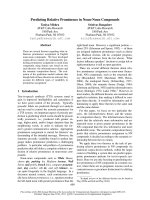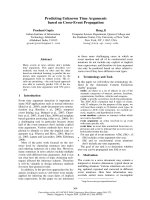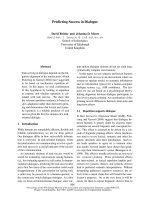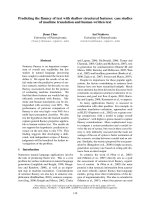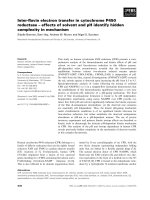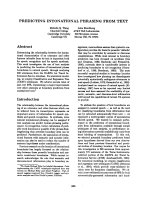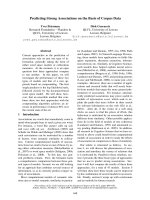báo cáo khoa học: " Predicting healthcare employees'''' participation in an office redesign program: Attitudes, norms and behavioral control" ppsx
Bạn đang xem bản rút gọn của tài liệu. Xem và tải ngay bản đầy đủ của tài liệu tại đây (253.67 KB, 9 trang )
BioMed Central
Page 1 of 9
(page number not for citation purposes)
Implementation Science
Open Access
Research article
Predicting healthcare employees' participation in an office redesign
program: Attitudes, norms and behavioral control
David C Mohr*
1,2
, Carol VanDeusen Lukas
1,2
and Mark Meterko
1,2
Address:
1
Center for Organization, Leadership and Management Research, Department of Veterans Affairs, Boston, Massachusetts, USA and
2
Department of Health Policy and Management, Boston University School of Public Health, Boston, Massachusetts, USA
Email: David C Mohr* - ; Carol VanDeusen Lukas - ; Mark Meterko -
* Corresponding author
Abstract
Background: The study examined the extent to which components based on a modified version
of the theory of planned behavior explained employee participation in a new clinical office program
designed to reduce patient waiting times in primary care clinics.
Methods: We regressed extent of employee participation on attitudes about the program, group
norms, and perceived behavioral control along with individual and clinic characteristics using a
hierarchical linear mixed model.
Results: Perceived group norms were one of the best predictors of employee participation.
Attitudes about the program were also significant, but to a lesser degree. Behavioral control,
however, was not a significant predictor. Respondents with at least one year of clinic tenure, or
who were team leaders, first line supervisor, or managers had greater participation rates. Analysis
at the clinic level indicated clinics with scores in the highest quartile clinic scores on group norms,
attitudes, and behavioral control scores were significantly higher on levels of overall participation
than clinics in the lowest quartile.
Conclusion: Findings suggest that establishing strong norms and values may influence employee
participation in a change program in a group setting. Supervisory level was also significant with
greater responsibility being associated with greater participation.
Background
In healthcare, organizations continually strive to imple-
ment new programs designed to improve patient care.
Some recent programs have focused on implementing
electronic health records [1], pay-for-performance [2],
and redesigning practice to meet the needs of chronically
ill patients [3]. Several studies have also examined the
extent to which different practices may lead to effective
implementation of changes, and these studies often focus
on beliefs and attitudes of the individual participant [4,5].
Less frequently studied is the impact of the activities of
coworkers on participation of their fellow employees on
overall implementation success. The purpose of this study
was to examine how employee attitudes, perceived group
norms, and perceived behavioral control predict partici-
pation in an innovative outpatient clinic redesign pro-
gram designed to improve clinic operations and reduce
patient waiting times. To do so we apply a model using
variables based upon the Theory of Planned Behavior
(TPB) [6,7].
Published: 2 November 2008
Implementation Science 2008, 3:47 doi:10.1186/1748-5908-3-47
Received: 11 April 2007
Accepted: 2 November 2008
This article is available from: />© 2008 Mohr et al; licensee BioMed Central Ltd.
This is an Open Access article distributed under the terms of the Creative Commons Attribution License ( />),
which permits unrestricted use, distribution, and reproduction in any medium, provided the original work is properly cited.
Implementation Science 2008, 3:47 />Page 2 of 9
(page number not for citation purposes)
Open Access
The setting for the study is the U.S. Veterans Health
Administration (VA); which operates the largest health-
care organization in the public sector. VA has experienced
a surge in demand for care from an aging veteran popula-
tion requiring more healthcare services [8]. Thus, reducing
wait times is a high priority. Beginning in 1999, VA collab-
orated with the Institute for Healthcare Improvement
(IHI) to launch a national initiative to diffuse the princi-
ples of Open Access across primary care clinics and five
specialty clinics [9]. IHI worked with VA for 18 months to
implement Open Access using a Framework for Spread
model [10].
Open Access, or Advanced Clinic Access (ACA) as it is
called in VA, is a patient-centered approach with the goal
of providing clinic appointments at the time the patients
wants to be seen [11-13]. The program espouses a set of
ten change principles for clinic management based on the
concepts of shaping the demand (e.g., working down the
backlog), matching supply (e.g., providers have an appro-
priate number of patients on their panel) and redesigning
the system to improve supply and demand balance (e.g.,
planning for periods of provider absence) [11]. ACA was
not a mandated program within VA during the study
period, but was strongly encouraged and promoted as a
way to alleviate the appointment wait time problem
brought on by growing patient demand.
Studies of ACA suggest that it has had a positive impact on
several dimensions, including an increase in the propor-
tion of patients being able to see their own provider [12],
more productive patient-provider visits, increased physi-
cian compensation, higher net gains for clinics, more effi-
cient operations, decreased use of urgent care and higher
patient satisfaction scores [13,14], reduced demand for
office visits [15], greater sustained enrollment in managed
care plans [11], and less work demands on employees
[14]. During the first 18 months of the ACA implementa-
tion program in 1999, the average waiting time for pri-
mary care appointments were reduced from 60 days to 28
days. Furthermore, the improvements were sustained,
with waiting times averaging less than 25 days in key clin-
ics in September 2004 [10].
The spread plan involved four components: 1) organiza-
tional infrastructure, involving a focus on leadership com-
mitment and support, technical support, measurement
system to monitor and provide feedback, knowledge
management system to document information, progress,
issues, and questions; 2) information, including the dis-
tributing information about ACA, making the business
case for ACA and transition materials; 3) communication
of general and technical information about ACA by iden-
tifying and using key respected messengers; and 4) lever-
aging the dynamics of social systems to promote spread,
including the recruitment of individuals who adopt new
systems, developing communities of practices, and using
various motivators, and incentives.
The current study is part of a larger comprehensive evalu-
ation of the implementation and effectiveness of ACA that
examined program implementation structure and activi-
ties, staff capabilities, waiting times, and patient satisfac-
tion [16]. A recent article, based on part of the evaluation
study conceptual model, presents facility level findings on
the factors contributing to implementation of the pro-
gram from the perspective of employees and facility level
program managers [17]. We have also documented the
effects of the program on facility level waiting times and
patient satisfaction [18]. The present study is focused on
examining the extent to which individual attitudes and
beliefs were related to participation in specific change pro-
gram aims. We apply a well-used theory from psychology
to guide our study.
Theory of Planned Behavior
The theory of planned behavior (TPB) [6,7] postulates
that behavior is influenced by intentions to perform a spe-
cific volitional behavior. Behavioral intentions are influ-
enced by attitudes about the behavior, norms and
perceived behavioral control. 'Attitude about the behav-
ior' is a function of beliefs about consequences of the
behavior and an evaluation of those consequences. The
'group norms' component is a function of social expecta-
tions to perform the behavior and motivation to comply
with the social group's wishes. Third, 'perceived behavio-
ral control' is the perception of the ease or difficulty of
performing the behavior based on the potential actor's
sense of his/her ability and experience.
A review of studies on physical activity has found strong
support for this model as predictive of behavior [19]. Fur-
ther, research conducted in healthcare settings has found
positive relationship between physician's attitudes,
beliefs, and perceived behavioral control and their pro-
motion of mammography screening [20], education
about sexually transmitted diseases provided to adoles-
cents [21], smoking cessation [22], and individual health
screening and physician visits [23]. The theory has also
been applied in the study of employee turnover [24]
among other areas.
However, we were unable to identify any studies of TPB
that considered behavior within the explicit context of a
team setting. In a team, several individuals are working
collaboratively toward a common goals such as the imple-
mentation of an innovation. The decision of any given
individual to participate in the innovation, and to do so
Implementation Science 2008, 3:47 />Page 3 of 9
(page number not for citation purposes)
with enthusiasm or just at the margin, may be influenced
by the participation and behaviors of coworkers.
For our study, we borrow themes from the model to
develop our analysis. We note this is not a pure empirical
test of the theory. Instead, we use the theory to help in our
testing and identification of factors that may lead to
employee participation. We do not test intention to
engage in the behavior as specified in the model, but do
model the actual behavior itself.
Current study
We hypothesized that the three components of TPB – atti-
tudes about the behavior, perceived group norms, and
perceived behavioral control – would relate positively to
extent of behavioral participation in the ACA program.
The study was conducted as a cross-sectional analysis. We
modeled participation at an individual level and at a clinic
level.
Methods
Setting
The present study involved the secondary analysis of data
from a national evaluation of the ACA program involving
78 medical centers selected to represent a range of average
patient wait times [16]. Some of these medical centers had
multiple primary care outpatient clinics in different loca-
tions. Thus, a total of 92 unique primary care clinics were
involved in the study. The overall ACA evaluation study
also involved specialty clinics in five areas. However, the
practice patterns (e.g., time to see patients, procedures,
staffing) of specialty clinics are different on several dimen-
sions (e.g., time to see patients, procedures, staffing) com-
pared to primary care clinics. We elected to focus on
respondents who self-described themselves as working in
primary care in order to control the scope of the present
study.
Procedure
The data source for the study was a survey of employees
working in outpatient care. The survey consisted of four
sections. In the first section, 'General Background',
employees were asked to indicate the clinical area(s) in
which they worked, the amount of time spent in each
area, their supervisory status, professional role, and job
tenure. In the second section, 'Changes to Improve Clinic
Access', employees were asked to indicate their involve-
ment in activities related to each of the ACA key changes,
and to report their participation in various ACA spread
activities. The third section of the questionnaire focused
on issues such as attitudes about the program, perceived
group norms, and influences on participating in the pro-
gram. In the final section, 'Summing Up', employees were
asked for their perceptions of the impact of ACA on their
own work life, on the quality of patient care, and on
patients' satisfaction with care and service.
A point of contact (POC) had been designated at each
medical facility as part of the national ACA initiative. Sur-
vey packets consisting of a cover letter, questionnaire, and
pre-paid business reply envelop addressed directly to a
third-party data entry vendor were mailed to each POC,
who then distributed the packets to clinic employees. The
survey was anonymous; packets were addressed to 'Pri-
mary Care Staff Member', and no individual respondent
ID number appeared on the questionnaire. To increase
response rate, a second wave of surveys was distributed to
all employees three weeks later after the initial distribu-
tion.
Participants
A total of 9,053 surveys were distributed to all staff,
including physicians, nurses, and program support assist-
ants. The surveys were distributed to five specialty care
clinical areas (cardiology, audiology, eye care, orthoped-
ics, and urology) at the 78 evaluation study hospitals, but
primary care clinic employees were the focus of the study.
We obtained a response rate of 39% overall and 40% in
primary care. We excluded respondents (n = 48) who indi-
cated that they spent less than half of their time in primary
care.
Participation in ACA
Participants were instructed to indicate whether or not
they directly participated in each of the ten change activi-
ties designed to improve access. The ten items of the
change initiative were presented along with a brief defini-
tion and example using language that would be familiar
to employees according to pre-administration review by
an advisory group of field staff. For example, the change
principle of 'work down the backlog' was clarified by add-
ing the example: 'adding extra overbook slots to sched-
ules, extending clinic hours, adding clinic sessions,
reviewing wait list to see if medical needs could be met by
phone call or other means.' Responses were coded as
either participated (1) or did not participate (0). The total
number of activities that the individual participated in
was computed. Cronbach's alpha for this measure of
extent of participation in the intervention implementa-
tion was 0.82. Table 1 displays the list of activities, how
they were described, and reported rate of involvement.
Predictor variables
Three scale scores representing attitude about the behav-
ior, perceived group norms, and perceived behavioral
control were computed; items were assigned to scales
based on face-validity. All items were assessed on a five-
point Likert scale ranging from one (Strongly Disagree) to
five (Strongly Agree). 'Attitude about the behavior' was
Implementation Science 2008, 3:47 />Page 4 of 9
(page number not for citation purposes)
assessed by four items that elicited employee perceptions
of the effectiveness of the ACA program, belief that wait
times are a problem to be addressed, and whether the pro-
gram led to improved quality of care. 'Perceived group
norms' was assessed with four items. These items elicited
employee perceptions regarding leadership priority for
the ACA program, the extent of discussion of the program
at employee meetings, the extent of team consensus that
ACA is being implemented, and that a well-respected
team member is vocalizing support for the efforts. 'Per-
ceived behavioral control' was assessed with three items
that asked if the team was able to adapt ACA to meet their
clinic needs, and about the extent of influence in manag-
ing care and making improvements using the model.
Cronbach's alpha for the three scales was 0.78, 0.81, and
0.80, respectively.
Individual and facility control variables
In the model we also included several control variables at
both the individual and facility level that prior research
suggested might have an effect individuals' participation
in the ACA program.
Individual characteristics
We included variables relating to the individual's role in
the clinic: full-time status, clinic tenure, managerial level,
and occupation. Individuals were dichotomously coded
as having full-time status if they reported at least 32 hours
or more per week in the clinic. Clinic tenure was as a
dichotomous variable representing whether or not the
individual had worked in the same clinic for at least one
year. Three dichotomous variables were created to repre-
sent level of managerial responsibility. These variables
were 'team leader', 'first line supervisor', and 'manager',
with individuals having no managerial status as the refer-
ent group. We also created dichotomous flag variables for
multiple professions, including physician, nurse practi-
tioner, registered nurse, and program support assistant,
the referent group in the series were all other clinic
employees (e.g., licensed practical nurses, other technical
occupations). Finally, we also measured overall job satis-
faction using the item: 'Considering everything, how sat-
isfied are you with your job?'. Responses ranged from one
(Strongly Disagree) to five (Strongly Agree). Individuals
Table 1: Ten key principles of ACA as assessed on the survey.
Item Percent of Employees Reporting Involvement
Work down the backlog (for example, by adding extra overbook slots to schedules,
extending clinic hours, adding clinic sessions, reviewing wait list to see if medical needs could
be met by phone call or other means)
53
Reduce demand
(for example, by extending reappointment intervals, creating alternatives to face-to-face
visits, and using referral guidelines)
51
Understand supply and demand (for example, by knowing how many appointment slots
a clinic has, knowing what the provider panel size cap is, knowing how many patients come
in, call in, or are scheduled each day for the clinic)
52
Reduce appointment types
(for example, by reducing the number of separate clinic profiles, standardizing the length of
appointments)
27
Plan for contingencies
(for example, by anticipating and planning for situations like provider leaves and the annual
flu vaccination season)
40
Manage the constraint
(for example, by figuring out where the 'logjams' occur in your patient care process and
figuring out actions to deal with them)
29
Optimize the care team
(for example, by using standard protocols, matching patient needs to skills of appropriate
team members, not necessarily always a physician)
46
Synchronize patient, provider and information
(for example, by starting clinic on time, checking charts for completeness, accuracy and
presence at appointment)
51
Predict and anticipate patient needs at the time of the appointment (for example,
by using regular clinic team 'huddles' to communicate and deal with possible situations that
may arise, using clinical reminders to get as much done in each visit as possible)
47
Optimize rooms and equipment
(for example, by having the same supplies available in each exam room, making sure supplies
are continuously stocked, using 'open' rooming)
48
* A total of 2,242 employees provided responses. The question stem appears below. Which if any of these efforts to improve veterans' access to
care have you been directly involved in? You may check more than one. You should check all changes that you were involved in regardless of whether
the change was successful or not.
Implementation Science 2008, 3:47 />Page 5 of 9
(page number not for citation purposes)
with greater job satisfaction have been found to be more
likely to participate in the change programs [27][28].
Facility context
Two facility level variables were also included in the
model: clinic size and teaching affiliation. Clinic size was
measured as the number of full-time equivalent employ-
ees and was reported by the POC at each facility. This was
included in the model because research suggests that size
has a pervasive influence on several outcome variables,
with larger size having a negative influence on outcomes.
We also included teaching affiliation. Resident physicians
can work in primary care clinics at teaching affiliated hos-
pitals. Although, residents were not included in our survey
there may be differences in the way clinics are operated in
academic affiliated settings.
Data Analysis
The study hypotheses were tested using a hierarchical
mixed linear model. We used this approach to account for
clustering of employees in primary care clinics. This pro-
vides an advantage over traditional ordinary least squares
(OLS) models because the interdependence of variables
within a given unit of observation is not considered using
OLS, and estimates may be misstated. Two models were
estimated. The first model excluded employee ratings of
attitudes, norms, and perceived behavioral control. We
regressed individual characteristics and facility context
variables on our computed participation in ACA. In the
second model, we included the measures of the three key
TPB variables: respondents' attitude toward the interven-
tion, their perceptions of group norms regarding the value
of the intervention, and their perceive control over their
participatory behavior. By estimating two separate models
in this manner we were able to examine the increase in
variance accounted for when the predictor variables of
interest were added to the baseline model. In both mod-
els, clinic was included as a random effects variable to
account for the clustering of respondents by clinic.
Missing values were deleted list-wise, so that all observa-
tions had complete data for the analysis. Due to missing
values, our total sample size was 2,201. We used Optimal
Design Software to compute power analysis for our regres-
sion model and found our study had power greater than
0.80 to detect small effect sizes of 0.20 with an average of
25 respondents per group and 82 groups [25].
In order to examine how level of participation was
affected at the clinic level by our predictor variables, we
conducted a second set of analyses. To begin, we created
three groups of clinics (top 25%; middle 50%; and bot-
tom 25%) based on their average score for each of the
three TPB factors. We then used analysis of covariance
(ANCOVA) to compare these groups on their mean level
of clinic participation. The covariates included clinic size
and teaching affiliation. To provide more stable estimates
at the clinic level, we only included those clinics (n = 82)
with ten or more respondents.
Results
Sample characteristics
The majority of the sample reported working full-time in
the clinic (84%) and having been in the clinic for at least
one year or longer (85%). Most of the sample (74%)
reported not having any managerial authority, 16% indi-
cated they were team leaders, 5% reported being a first
line supervisor, and 5% reported being a manager.
Regarding profession, 20% of the sample reported being a
medical officer, 12% were nurse practitioners, 20% were
nurses, and 21% reported themselves as program support
assistants. Although there was some variation at the clinic
level in the study sample, these percentages approximate
the known staffing distributions in VA primary care clinics
on a nationwide basis.
The individual participation scale mean was 4.65 (SD =
3.05) on a ten-point scale, indicating that the average
respondents engaged in just under half of the ACA change
activities. Attitudes about practice, perceived group norms
and perceived behavioral control all correlated signifi-
cantly with participation rate, with correlations ranging
from r
= 0.24 to 0.32, p < 0.001. We examined the normal-
ity of these variables before running regression models; in
all cases, the variables were normally distributed with
skewness and kurtosis not larger than |1|.
Next, we conducted hierarchical linear mixed model anal-
yses with participation as the dependent variable and
clinic as the random effect. All variables were standard-
ized to facilitate comparison of coefficients. Computation
of the intraclass correlation indicated that approximately
4% of the variance in staff participation was accounted for
at the clinic level [26]. This variance would have been con-
sidered as error variance in an OLS model not taking into
account the nesting of employees in clinics.
Model 1, including only individual characteristics and
facility context, accounted for 17% of the variance based
on the pseudo r-square. When we added the three TPB var-
iables (Model 2) the variance accounted for increased to
23%. Of the TPB factors, perceived group norms had the
strongest association with participation (β
= 0.23, p <
0.01), while attitude about the behavior (β
= 0.07, p <
0.01) was less strongly associated, but still significant. Per-
ceived behavioral control, however, was not significant.
Several covariates were significant as well in Model 2:
clinic tenure of at least one year (β
= 0.15, p < 0.01); being
a physician (β
= 0.05, p < 0.05); being a nurse practitioner
Implementation Science 2008, 3:47 />Page 6 of 9
(page number not for citation purposes)
(β = 0.12, p < 0.01); and being a registered nurse (β = 0.09,
p
< 0.01). The three variables coded to indicate supervi-
sory level were all significant compared to individuals
without supervisory status (referent group), further,
parameter estimates increased as one moved up the level
of supervisory hierarchy: team leader (β
= 0.13, p < 0.01);
first line supervisor (β
= 0.14, p < 0.01) and manager (β =
0.21, p
< 0.01).
Non-significant predictors included several individual
characteristics (full-time status, job satisfaction, and being
a program support assistant) as well as team size and aca-
demic affiliation. Descriptive statistics and standardized
coefficient estimates from Model 1 and Model 2 for all
variables are reported in Table 2.
Next, we aggregated all TPB variable scores to the clinic
level and identified those clinics that were in the top and
bottom quartile and the middle 50% on each of the three
dimensions. We then compared the mean level of partici-
pation in the ACA intervention across those groups while
controlling for clinic size and teaching affiliation via
ANCOVA. The overall average level of participation at the
clinic level was 4.47 with a range of 2.08 to 6.46.
ANCOVA results for perceived group norms were signifi-
cant, F
(5,76) = 5.10, p < 0.001. Post-hoc Tukey group
comparisons indicated that the bottom quartile of clinics
on perceived group norms had significantly lower partici-
pation scores than any other group; the difference in par-
ticipation between the highest and lowest quartile groups
was 1.13, d
= 0.29. Similar results were observed for atti-
tudes about the behavior, F
(5,76) = 4.70, p < 0.001, and
behavioral control, F
(5,76) = 4.89, p < 0.001. For both of
these other TPB factors, the bottom quartile clinics also
had scores that were significantly lower than the other
comparison groups (d
= 0.28 and 0.22 respectively; see
Table 3).
Discussion
The present study explored the ability of variables repre-
senting three key constructs from the theory of planned
behavior to explain employee participation in a work-
place program designed to improve patient access to care.
We predicted that each TBP factor would be related to par-
ticipation, with perceived group norms being especially
important.
We found partial support for the hypothesized model.
Employee perceptions that group norms favored the ACA
program and those whose own attitudes toward ACA were
positive demonstrated greater involvement in ACA imple-
mentation. One implication of this finding is that manag-
ers looking to facilitate employee participation in an
intervention may find it effective to strengthen perceived
group norms regarding the intervention. This might be
achieved by extensively publicizing the implementation
Table 2: Hierarchical Linear Mixed Model Regression Predicting Participation.
Model 1 Model 2
Mean SD β 95% CI β 95% CI
Intercept .05 .00–.11 .05 .00–.11
Full-time status (1 = yes) 0.84 .01 03–.06 .02 02–.06
Clinic tenure greater than one year 0.85 .14** .10–.18 .15** .11–.19
Team leader (ref = no) 0.16 .14** .10–.18 .13** .09–.17
First line supervisor (ref = no) 0.05 .15** .11–.19 .14** .11–.18
Manager (ref = no) 0.06 .24** .20–.27 .21** .17–.25
Physician 0.21 .05* .00–.10 .05* .00–.09
Nurse Practitioner 0.12 .12** .07–.16 .12** .07–.16
Registered Nurse 0.20 .08** .03–.13 .09** .04–.14
Program Support Assistant 0.20 04 09 01 03 07 02
Job satisfaction 3.79 1.22 .18** .14–.22 .02 02–.07
Size of Primary Care clinic 77.45 45.67 .01 06–.08 .00 07 06
Academic Affiliation (1 = yes) 0.49 02 09 04 01 08 04
Step 2
Attitudes about ACA 3.47 0.69 .07** .02–.12
Perceived group norms 3.63 0.73 .23** .18–.29
Perceived behavioral control 3.13 1.04 .05 .00–.10
Pseudo R
2
.17 .23
Model 1 includes only control variables while Model 2 includes the three additional predictor variables to examine the additional variance explained
above the control variables.
Standardized parameter estimates and standard error reported in table along with means (percentages) and standard deviations for study variables.
A total of 2,201 participants in 92 clinic areas were used in the analysis. * p < 0.05; ** p < 0.01.
Implementation Science 2008, 3:47 />Page 7 of 9
(page number not for citation purposes)
effort and ensuring that it is thoroughly discussed in meet-
ings by managers and coworkers. We also found attitudes
about the program to be a significant predictor. This sug-
gests that believing the program will be useful may be an
incentive to participate, consistent with research. A man-
ager could emphasize the benefits of the program by
stressing the goals of the process, and how meeting the
objectives can lead to better personal and customer care
outcomes. The third TPB factor, perceived behavioral con-
trol, was not significant in the overall model; employee
perceptions of the degree of control they had over the pro-
gram (e.g, the extent to which they could adapt ACA to
best suit their clinic conditions) was not a relevant factor
in overall participation in this study.
With regard to the demographic and other factors
included in our model, we found that level of supervisory
responsibility had a large effect on participation. This is
consistent with the findings and theoretical research sug-
gesting management plays a key role implementing
change programs [5,27]. The effect appeared to increase as
level of responsibility increased. We also note the possi-
bility that perceived group norms may be strengthened by
participation of senior leaders in a clinic area.
In addition, employees who have been in the clinic for at
least a year were more likely to participate in the program,
possibly reflecting their greater identification with the
clinic aims and program implementation goals. Signifi-
cant effects were also found for occupation level, with
nurse practitioners, registered nurses, and physicians par-
ticipating in a greater number of activities compared to
other clinical employees.
Contrary to expectation based on previous research, we
did not find job satisfaction to be a significant predictor of
participation in the ACA intervention. To explore this fur-
ther, we subsequently tested a hierarchical linear mixed
model that included interaction terms between job atti-
tudes and the three key TPB predictors. None of the inter-
action terms were significant. These findings suggest that
employee job satisfaction may not be a key factor in pre-
dicting participation in an intervention; perhaps those
who are less satisfied are more motivated to implement
changes that may improve their work life.
In the clinic-level analyses, we found that the level of par-
ticipation was higher within clinics in the top quartile on
either attitudes about the behavior or perceived behavio-
ral control than it was in those clinics in the middle half
or bottom quartile of the TPB variable distribution This
suggests a linear effect for these TPB variables at a clinic
level. For perceived group norms, the difference between
the top quartile and middle half was not significantly dif-
ferent. However, the top quartile and middle clinics were
both significantly higher compared to the bottom quartile
clinics. We take this finding to suggest that a moderate
level of peer support for an intervention may serve as a tip-
ping point for encouraging broader employee participa-
tion in a change effort. Interventions at a clinic or group
level designed to increase perceived group norms for par-
ticipating in the program may lead to greater employee
involvement in the proposed implementation program.
Limitations
The study was a cross-sectional field research study and
shares several of the limitations of this design. A concern
is a lack of experimental control, so any causal inferences
need to be examined with caution. However, there is
growing sentiment that experimental controls may not
always be appropriate to evaluate implementation stud-
ies. Measures for all variables were obtained the data from
the same source and consequently their inter-relation-
ships may be due in part to common method variance.
However, questions about individual participation on
each of the ten activities were scored dichotomously, as
were demographic questions. Employees rated job satis-
faction and the three components of the theory on a Lik-
ert-type scale. These differences in response options may
partially mitigate the common method variance effect.
A total of 40% of the sample responded to the survey, rais-
ing concerns of non-response bias. For example, respond-
ents may over-represent those who participated in the
ACA program. We did, however, find 12% of the survey
respondents indicated that no participation in any of the
ACA practices. Thus, some individuals who did not partic-
Table 3: Clinic adjusted mean and standard deviation based on ANCOVA results.
Attitudes about the program Perceived Group norms Perceived behavioral control
Mean SD Mean SD Mean SD
Top 25% 5.21 .78 4.68 .89 5.11 .78
Middle 50% 4.37 .88 4.77 .93 4.51 .89
Bottom 25% 3.89 .97 3.55 .71 3.72 .95
Analysis controls for academic affiliation and number of employees in clinic.
Implementation Science 2008, 3:47 />Page 8 of 9
(page number not for citation purposes)
ipate in ACA nonetheless did complete the survey, sug-
gesting that the present results are not based solely on the
sub-sample of participants who might not be representa-
tive in some way.
Future research
The present strong results regarding the impact of per-
ceived group norms raises the question of whether this
finding would generalize to specialty clinic areas using the
same program as well as outpatient clinics trying to imple-
ment different types of clinical design programs or other
innovations, such as electronic health record systems. We
did not find job satisfaction to be related to participation
as would be expected. Future research should examine if
job satisfaction is related to other implementation activi-
ties, or if the effects of perceived group norms, attitudes,
and behavioral control are more important variables and
worth additional study.
We found variables based around concepts of TPB to be
important predictors of participation. We would advocate
a more complete test of the theory in the future as it relates
to implementation programs in a team setting. Questions
on the components to fully assess the sub-components
and beliefs underlying each of the three predictors were
used in our study as proxy measures for the constructs.
Most research has examined only individual level aspects
of TPB, but looking at the theory in the work setting may
also lead to interesting findings and extension of prior
findings. The setting and type of intervention could also
be studied. The present study focused on clinical opera-
tions, but it is possible that different types of change pro-
grams may be less influenced by perceived group norms
and more influenced by attitudes or perceived behavioral
control.
Summary
Our findings indicate that perceived group norms and
employee's attitudes regarding the value of the interven-
tion were related to participation in the implementation
of an innovation; however, perceived behavioral control
was not found to be a significant predictor. These findings
partially supported hypotheses derived from the theory of
planned behavior. Supervisory level also played a role in
the participation. Individuals with greater managerial
authority appeared to be more involved in the program.
The implication would suggest that a climate where all
team members recognize their colleagues are participating
in the program, discussing the program at meetings, and
having visible team leaders may enhance participation in
operational change programs.
Competing interests
The authors declare that they have no competing interests.
Authors' contributions
DCM conceived this manuscript, and led the writing and
analyses. CVL and MM participated in the conceptualiza-
tion and drafting of this manuscript. All authors read and
approved the final manuscript.
Acknowledgements
The research reported here was supported by the Department of Veterans
Affairs, Veterans Health Administration, Health Services Research and
Development Service (IMV 04-055). The authors' salaries were supported
by the Department of Veterans Affairs during this project. The findings and
conclusions in this document are those of the authors, who are responsible
for its contents, and do not necessarily represent the views of the U.S.
Department of Veterans Affairs.
References
1. Jha AK, Ferris TG, Donelan K, DesRoches C, Shields A, Rosenbaum
S, D B: How common are electronic health records in the
United States? A summary of the evidence. Health Affairs 2006,
25:469-507.
2. Young GJ, White B, Burgess JF Jr, Berlowitz D, Meterko M, Guldin M,
BG B: Conceptual issues in the design and implementation of
pay-for-quality programs. American Journal of Medical Quality
2005, 20:144-150.
3. Wagner EH, Austin BT, Davis C, Hindmarsh M, Schaefer J, Bonomi A:
Improving chronic illness care: Translating evidence into
action. Health Affairs 2001, 20:64-78.
4. Helfrich C, Savitz L, Swiger K, B W: Adoption and implementa-
tion of mandated diabetes registries by community health
centers. American Journal of Preventive Medicine 2007, 33:S50-S65.
5. Klein KJ, Buhl Conn A, Speer Sorra J: Implementing computer-
ized technology: An organizational analysis. Journal of Applied
Psychology 2001, 86:811-824.
6. Ajzen I: From intentions to actions: a theory of planned
behavior. In Action-control: from cognition to behavior Edited by: Beck-
mann JKJ. Heidelberg: Springer; 1985.
7. Ajzen I: The theory of planned behavior. Organizational Behavior
and Human Decision Processes 1991, 50:179-211.
8. Blair B, Mark C: Veterans Affairs Department: balancing
budget crunch with patients' needs at VA. Federal Times 2002,
14:18.
9. Schall MW, Duffy T, Krishnamurthy A, Levesque O, Mehta P, Murray
M: Improving patient access to the Veterans Health Admin-
istration's primary care and specialty care clinics. Jt Comm J
Qual Saf 2004, 30(8):415-423.
10. Nolan K, Schall MW, Erb F, Nolan T: Using a framework for
spread: the case of patient access in the Veterans Health
Administration. Jt Comm J Qual Patient Saf 2005, 31(6):339-347.
11. Murray M, Tantau C: Redefining open access to primary care.
Manag Care Q 1999, 7(3):45-55.
12. Aiello K: Open access appointments in army primary care
clinics. Military Medicine 2005, 170:370-374.
13. O'Hare CD, Corlett J: The outcomes of open-access schedul-
ing. Family Practice Management 2004:35-38.
14. Kennedy JG, Hsu JT: Implementation of an open access sched-
uling system in a residency training program. Fam Med 2003,
35(9):666-670.
15. Carlson B: Same-day appointments promise increased pro-
ductivity. Managed Care 2002, 11(12):43-44.
16. Lukas CV, Meterko M, Mohr D, Seibert MN: Implementation of a
clinical innovation: the diffusion of Advanced Clinic Access in
VA. In Health Care Organizations Conference: 2005 Virginia Common-
wealth University; 2005.
17. Lukas CV, Meterko M, Mohr D, Nealon Seibert M, Parlier R, Levesque
O, Petzel RA: Implementation of a clinical innovation: the case
of Advanced Access in the Department of Veterans Affairs.
J Ambul Care Manage 2008, 31(2):94-108.
18. Lukas C VanDeusen, Meterko M, Mohr D, Nealon Seibert M: The
Implementation and effectiveness of advanced clinic access.
2004 [ />ACA_FullReport.pdf]. HSR&D Management Decision and Research
Publish with BioMed Central and every
scientist can read your work free of charge
"BioMed Central will be the most significant development for
disseminating the results of biomedical research in our lifetime."
Sir Paul Nurse, Cancer Research UK
Your research papers will be:
available free of charge to the entire biomedical community
peer reviewed and published immediately upon acceptance
cited in PubMed and archived on PubMed Central
yours — you keep the copyright
Submit your manuscript here:
/>BioMedcentral
Implementation Science 2008, 3:47 />Page 9 of 9
(page number not for citation purposes)
Center, Office of Research and Development, Department of Veter-
ans Affairs
19. Hausenblas HA, Carron AV, Mack DE: Application of the theories
of reasoned action and planned behavior to exercise behav-
ior: A meta-analysis. Journal of Sport and Exercise Psychology 1997,
19:36-51.
20. Taylor VM, Montano DE, Koepsell T: Use of screening mammog-
raphy by general internists. Cancer Detection and Prevention 1994,
18:455-462.
21. Millstein SG: Utility of the theories of reasoned action and
planned behavior for predicting physician behavior: a pro-
spective analysis. Health Psychology 1996, 15(5):398-402.
22. Norman P, Conner M, Bell R: The theory of planned behavior
and smoking cessation. Health Psychology 1999, 18(1):89-94.
23. Sheeran P, Conner M, Norman P: Can the theory of planned
behavior explain patterns of health behavior change? Health
Psychology 2001, 20(1):12-19.
24. Van Breukelen W, Vlist R Van der, Steensma H: Voluntary
employee turnover: combining variables from the tradi-
tional turnover literature with the theory of planned behav-
ior. Journal of Organizational Behavior 2004, 25:839-914.
25. Liu X, Spybrook J, Congdon R, Martinez A, Raudenbush S: Optimal
design for multi-level and longitudinal research. 1.77th edi-
tion. HLM Software; 2006.
26. Singer JD: Using SAS PROC MIXED to fit multilevel models,
hierarchical models, and individual growth models. Journal of
Educational and Behavioral Statistics 1998, 24(4):323-355.
27. Kilman RH, Covin TJ: Corporate transformation. San Francisco:
Jossey-Bass; 1988.

